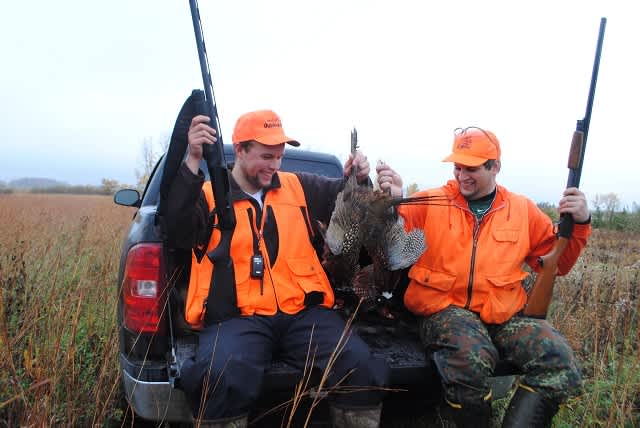Carrying On the Old-fashioned Michigan Pheasant Hunting Tradition
Bob Gwizdz 11.14.12

We were hanging around the kitchen and dining room, drinking coffee and eating donuts, when Tom Lounsbury, the ramrod of this particular expedition, asked me a simple question: “Remind you of anything?”
I knew exactly what he was getting at.
This is how pheasant hunting was 50 years ago. Lots of guys and maybe a dog or two–and we’re way more likely to be talking about a mongrel farm dog than some fancy-pants pointing breed–getting prepared to sweep the fallow fields, the ditches, and the fence rows.
I assume Lounsbury–who had invited me to participate in an “old-fashioned” pheasant hunt with a handful of other fellows–asked me the question as we are around the same age and were among the oldsters of this particular gathering. I did a quick scan of the room and then pronounced three things I noticed:
- Nobody had a back tag,
- Sure was a lot of orange showing, and
- Where were the kids?
Back in the day, you displayed your license on the back of your coat or vest, like a license plate. Hunting coats and game vests were tan. And kids? There were always kids, most of them carrying BB guns, going afield with dad. That’s how I remember it. Lounsbury, too.

My, how things have changed. Hunters began being required to wear hunter orange in the 1970s and back tags went out around the same time that computerized license sales began, sometime in the 1990s, I’d guess. But the lack of youngsters? That’s the biggest change.
These days, youngsters don’t have to go through that apprenticeship with BB guns until they’re 14 to become full partners in a hunt. Age requirements for hunters have been lifted. But most kids don’t bother with the small game hunting; they start out deer hunting. You just don’t see many of them small game hunting at all. That’s different.
It wasn’t until the mid 1960s that deer hunters outnumbered pheasant hunters in Michigan and it probably was at least another decade after that that most hunters could reasonably expect to kill a deer anywhere south of, say, Clare. Up until then small game was where it was at.
That part of our history is history.
“I’ll never forget all the hunters that crowded around our kitchen table,” said Lounsbury, who noted that we were on the same property (but in a different house) as his first recollection of pheasant hunting, back in the early 1950s. “We didn’t have room for everyone, it was standing room only. But by the time I was in junior high, I never saw those guys again.
“It changed here in the ‘60s,” Lounsbury continued. “You could see it. Farming techniques changed. When I was growing up, everybody had a few cows and chickens. A guy with 160 acres could raise a family and pay the bills.
“But I remember I had sisters in college and we had to have more income. I remember when my father sold the cows and went to work in a factory. He rented out the land. The farmer took out the hedge row and cleaned out the ditch. The habitat changed.”
Lounsbury divided us into three groups to attack the first field. A third came in from one direction, a third came in from another, while the final third lined the far end to serve as blockers. We put up fair batch of birds, but only one was a rooster that somehow negotiated a line of shotgun-toters unscathed. Rub, my English setter, gave me three solid points as we worked across the field, but all three were dull brown birds.
Not to worry Lounsbury said, as we had two more fields to hunt. The fields were divided by the county drain and we’d push from opposite sides until we converged. Then hold on.

I stayed on my dog’s butt, but it didn’t help much. Rub pointed. I moved up on him. He crept up a few yards and pointed again. And then again. Finally, a rooster exploded from the grass–still 40 yards ahead of us. That bird knew the game.
Rub found another scent. It was the same drill. The bird went up well in front of us. But we kept moving and, as we approached the drain, a couple of birds got up. Shots rang out. The birds fell. That was it.
Before noon we were back at the farm house, drinking coffee. That was different, too; back in the day, we’d have gone to the next farm. Now? The next farm didn’t have any habitat, anyway.
We ate lunch and discussed what had worked and what hadn’t. And we made plans–at least some of us did–to meet up in December and try it again.
Michigan pheasant hunting is not like it used to be. And it never will be again.
But it’s still a pretty good way to spend an autumn morning.
For more information on Michigan hunting go to michigan.org.

